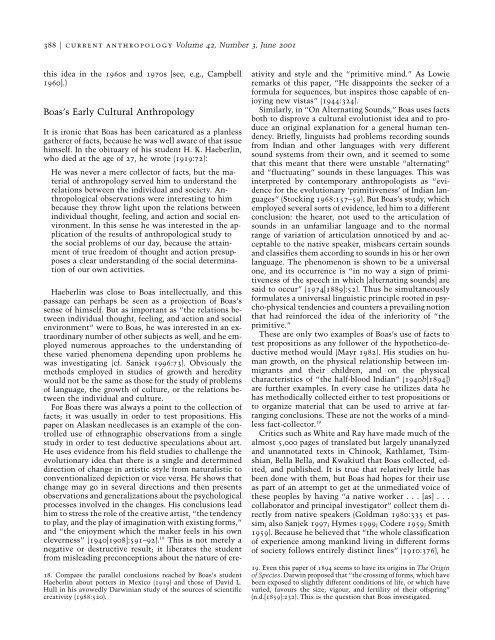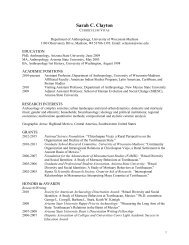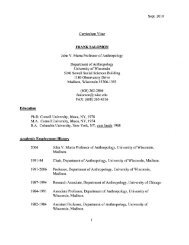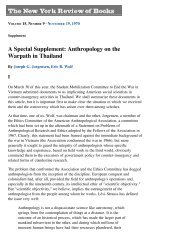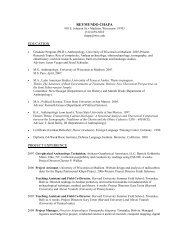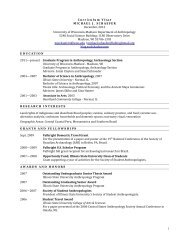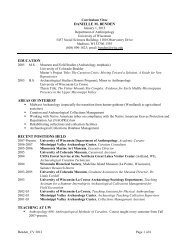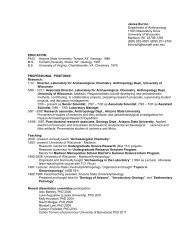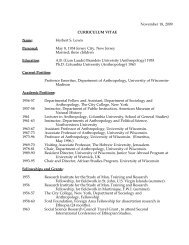Boas, Darwin, Science, and Anthropology1 - Department of ...
Boas, Darwin, Science, and Anthropology1 - Department of ...
Boas, Darwin, Science, and Anthropology1 - Department of ...
Create successful ePaper yourself
Turn your PDF publications into a flip-book with our unique Google optimized e-Paper software.
388 F current anthropology Volume 42, Number 3, June 2001<br />
this idea in the 1960s <strong>and</strong> 1970s [see, e.g., Campbell<br />
1960].)<br />
<strong>Boas</strong>’s Early Cultural Anthropology<br />
It is ironic that <strong>Boas</strong> has been caricatured as a planless<br />
gatherer <strong>of</strong> facts, because he was well aware <strong>of</strong> that issue<br />
himself. In the obituary <strong>of</strong> his student H. K. Haeberlin,<br />
who died at the age <strong>of</strong> 27, he wrote (1919:72):<br />
He was never a mere collector <strong>of</strong> facts, but the material<br />
<strong>of</strong> anthropology served him to underst<strong>and</strong> the<br />
relations between the individual <strong>and</strong> society. Anthropological<br />
observations were interesting to him<br />
because they throw light upon the relations between<br />
individual thought, feeling, <strong>and</strong> action <strong>and</strong> social environment.<br />
In this sense he was interested in the application<br />
<strong>of</strong> the results <strong>of</strong> anthropological study to<br />
the social problems <strong>of</strong> our day, because the attainment<br />
<strong>of</strong> true freedom <strong>of</strong> thought <strong>and</strong> action presupposes<br />
a clear underst<strong>and</strong>ing <strong>of</strong> the social determination<br />
<strong>of</strong> our own activities.<br />
Haeberlin was close to <strong>Boas</strong> intellectually, <strong>and</strong> this<br />
passage can perhaps be seen as a projection <strong>of</strong> <strong>Boas</strong>’s<br />
sense <strong>of</strong> himself. But as important as “the relations between<br />
individual thought, feeling, <strong>and</strong> action <strong>and</strong> social<br />
environment” were to <strong>Boas</strong>, he was interested in an extraordinary<br />
number <strong>of</strong> other subjects as well, <strong>and</strong> he employed<br />
numerous approaches to the underst<strong>and</strong>ing <strong>of</strong><br />
these varied phenomena depending upon problems he<br />
was investigating (cf. Sanjek 1996:73). Obviously the<br />
methods employed in studies <strong>of</strong> growth <strong>and</strong> heredity<br />
would not be the same as those for the study <strong>of</strong> problems<br />
<strong>of</strong> language, the growth <strong>of</strong> culture, or the relations between<br />
the individual <strong>and</strong> culture.<br />
For <strong>Boas</strong> there was always a point to the collection <strong>of</strong><br />
facts; it was usually in order to test propositions. His<br />
paper on Alaskan needlecases is an example <strong>of</strong> the controlled<br />
use <strong>of</strong> ethnographic observations from a single<br />
study in order to test deductive speculations about art.<br />
He uses evidence from his field studies to challenge the<br />
evolutionary idea that there is a single <strong>and</strong> determined<br />
direction <strong>of</strong> change in artistic style from naturalistic to<br />
conventionalized depiction or vice versa. He shows that<br />
change may go in several directions <strong>and</strong> then presents<br />
observations <strong>and</strong> generalizations about the psychological<br />
processes involved in the changes. His conclusions lead<br />
him to stress the role <strong>of</strong> the creative artist, “the tendency<br />
to play, <strong>and</strong> the play <strong>of</strong> imagination with existing forms,”<br />
<strong>and</strong> “the enjoyment which the maker feels in his own<br />
cleverness” (1940[1908]:591–92). 18 This is not merely a<br />
negative or destructive result; it liberates the student<br />
from misleading preconceptions about the nature <strong>of</strong> cre-<br />
18. Compare the parallel conclusions reached by <strong>Boas</strong>’s student<br />
Haeberlin about potters in Mexico (1919) <strong>and</strong> those <strong>of</strong> David L.<br />
Hull in his avowedly <strong>Darwin</strong>ian study <strong>of</strong> the sources <strong>of</strong> scientific<br />
creativity (1988:520).<br />
ativity <strong>and</strong> style <strong>and</strong> the “primitive mind.” As Lowie<br />
remarks <strong>of</strong> this paper, “He disappoints the seeker <strong>of</strong> a<br />
formula for sequences, but inspires those capable <strong>of</strong> enjoying<br />
new vistas” (1944:324).<br />
Similarly, in “On Alternating Sounds,” <strong>Boas</strong> uses facts<br />
both to disprove a cultural evolutionist idea <strong>and</strong> to produce<br />
an original explanation for a general human tendency.<br />
Briefly, linguists had problems recording sounds<br />
from Indian <strong>and</strong> other languages with very different<br />
sound systems from their own, <strong>and</strong> it seemed to some<br />
that this meant that there were unstable “alternating”<br />
<strong>and</strong> “fluctuating” sounds in these languages. This was<br />
interpreted by contemporary anthropologists as “evidence<br />
for the evolutionary ‘primitiveness’ <strong>of</strong> Indian languages”<br />
(Stocking 1968:157–59). But <strong>Boas</strong>’s study, which<br />
employed several sorts <strong>of</strong> evidence, led him to a different<br />
conclusion: the hearer, not used to the articulation <strong>of</strong><br />
sounds in an unfamiliar language <strong>and</strong> to the normal<br />
range <strong>of</strong> variation <strong>of</strong> articulation unnoticed by <strong>and</strong> acceptable<br />
to the native speaker, mishears certain sounds<br />
<strong>and</strong> classifies them according to sounds in his or her own<br />
language. The phenomenon is shown to be a universal<br />
one, <strong>and</strong> its occurrence is “in no way a sign <strong>of</strong> primitiveness<br />
<strong>of</strong> the speech in which [alternating sounds] are<br />
said to occur” (1974[1889]:52). Thus he simultaneously<br />
formulates a universal linguistic principle rooted in psycho-physical<br />
tendencies <strong>and</strong> counters a prevailing notion<br />
that had reinforced the idea <strong>of</strong> the inferiority <strong>of</strong> “the<br />
primitive.”<br />
These are only two examples <strong>of</strong> <strong>Boas</strong>’s use <strong>of</strong> facts to<br />
test propositions as any follower <strong>of</strong> the hypothetico-deductive<br />
method would (Mayr 1982). His studies on human<br />
growth, on the physical relationship between immigrants<br />
<strong>and</strong> their children, <strong>and</strong> on the physical<br />
characteristics <strong>of</strong> “the half-blood Indian” (1940b[1894])<br />
are further examples. In every case he utilizes data he<br />
has methodically collected either to test propositions or<br />
to organize material that can be used to arrive at farranging<br />
conclusions. These are not the works <strong>of</strong> a mindless<br />
fact-collector. 19<br />
Critics such as White <strong>and</strong> Ray have made much <strong>of</strong> the<br />
almost 5,000 pages <strong>of</strong> translated but largely unanalyzed<br />
<strong>and</strong> unannotated texts in Chinook, Kathlamet, Tsimshian,<br />
Bella Bella, <strong>and</strong> Kwakiutl that <strong>Boas</strong> collected, edited,<br />
<strong>and</strong> published. It is true that relatively little has<br />
been done with them, but <strong>Boas</strong> had hopes for their use<br />
as part <strong>of</strong> an attempt to get at the unmediated voice <strong>of</strong><br />
these peoples by having “a native worker ...[as]...<br />
collaborator <strong>and</strong> principal investigator” collect them directly<br />
from native speakers (Goldman 1980:335 et passim;<br />
also Sanjek 1997; Hymes 1999; Codere 1959; Smith<br />
1959). Because he believed that “the whole classification<br />
<strong>of</strong> experience among mankind living in different forms<br />
<strong>of</strong> society follows entirely distinct lines” (1910:376), he<br />
19. Even this paper <strong>of</strong> 1894 seems to have its origins in The Origin<br />
<strong>of</strong> Species. <strong>Darwin</strong> proposed that “the crossing <strong>of</strong> forms, which have<br />
been exposed to slightly different conditions <strong>of</strong> life, or which have<br />
varied, favours the size, vigour, <strong>and</strong> fertility <strong>of</strong> their <strong>of</strong>fspring”<br />
(n.d.[1859]:232). This is the question that <strong>Boas</strong> investigated.


